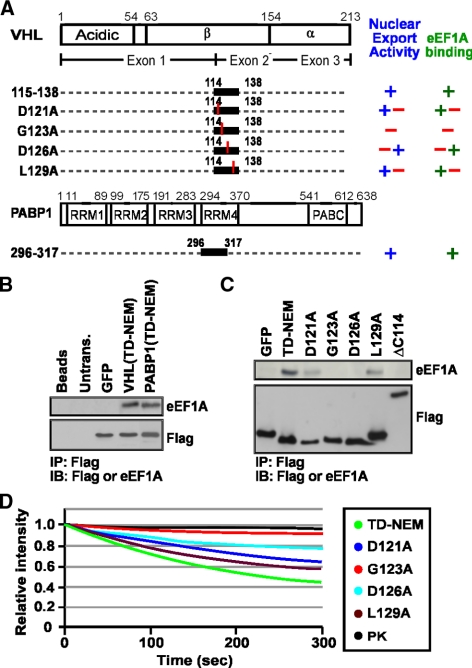Figure 8.
TD-NEM is sufficient for eEF1A interaction. (A) Schematic diagram depicts the TD-NEM of VHL encoded within residues 115–138 and alanine substitution of the key residues of TD-NEM. Schematic diagram also depicting the TD-NEM of PABP1 encoded between residues 296 and 317. (+), (+ −), (− +), and (−) indicate, in a decreasing order, the ability of the fusion proteins to interact with eEF1A or export from the nucleus. (B) The transcription-dependent nuclear export sequence, TD-NEM, of VHL and PABP1 is sufficient to interact with endogenous eEF1A. MCF-7 cells transiently expressing GFP alone or the TD-NEM sequences of VHL or PABP1 tagged with Flag and GFP were submitted to immunoprecipitation with anti-Flag beads and immunoblotted with anti-Flag or anti-eEF1A antibodies. TD-NEM refers to residues 114–138 of VHL and residues 298–317 of PABP1. (C) Conserved residues in TD-NEM are required for eEF1A interaction. TD-NEM refers to residues 114–138 of VHL. Flag and GFP-tagged D121A, G123A, D126A, and L129A indicate the amino acid that was substituted to alanine within residues 114–138 of VHL. Immunoprecipitation and Western blot was as described above. (D) Conserved residues in TD-NEM are required for efficient nuclear export. MCF-7 cells transiently expressing TD-NEM, D121A, G123A, D126A, or L129A fused to PK-GFP-NLS or expressing PK-GFP-NLS alone were subjected to the live cell FLIP nuclear export assay. The loss of nuclear fluorescence during cytoplasmic FLIP was monitored and graphed.

